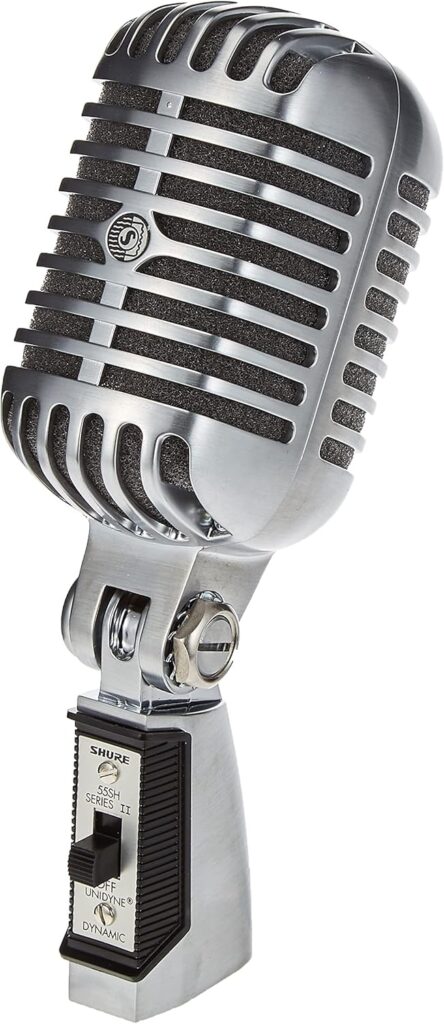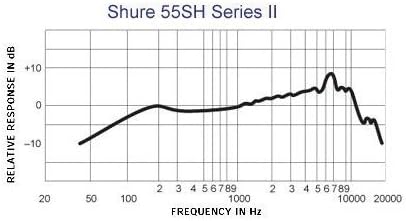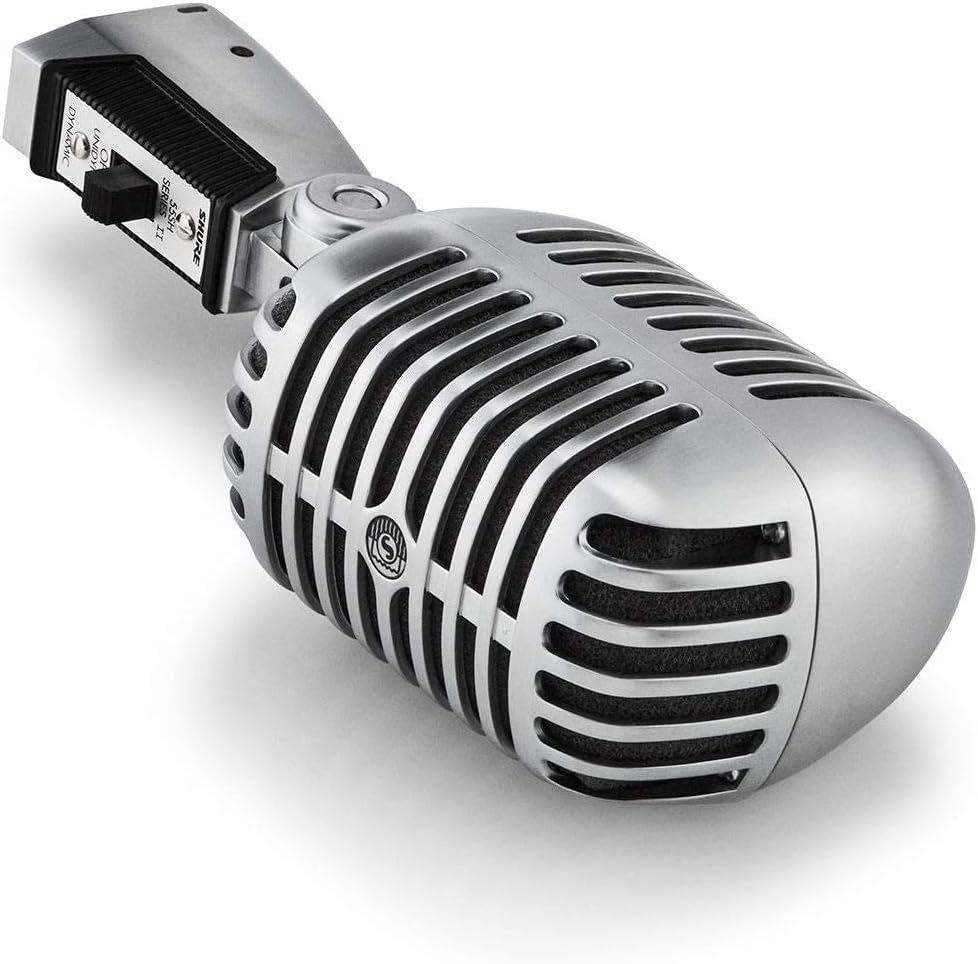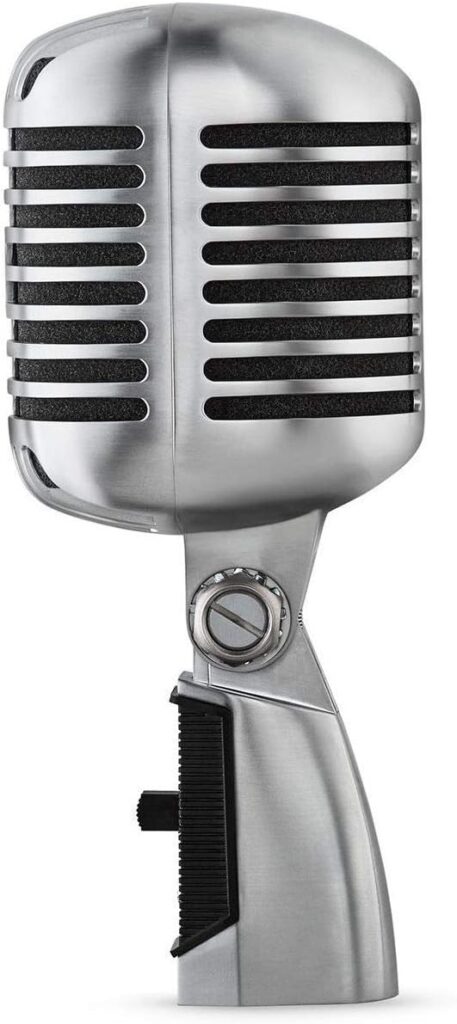Shure 55SH Series II Review
The Shure 55SH Series II is more than just a microphone—it’s an icon. With its unmistakable vintage design and robust performance, this dynamic microphone has been a staple in studios, stages, and broadcast booths for decades. Shure, a brand synonymous with audio excellence since 1925, has kept the 55SH Series II relevant by blending its retro aesthetic with modern engineering. In this review, we’ll explore its design, sound quality, build, applications, and overall value to determine if it still holds up in 2025’s competitive audio market.
Shure 55SH Series II Review
The first thing you notice about the Shure 55SH Series II is its look. Modeled after the original Shure 55 “Elvis Mic” from the 1950s, it sports a die-cast metal body with a satin chrome finish that screams mid-century cool. Its art deco-inspired grille and angular stand mount give it a distinctive silhouette that’s instantly recognizable. Weighing in at just over 1.4 pounds (626 grams), it feels substantial without being unwieldy—a testament to its durability.
The build quality is, as expected from Shure, exceptional. The all-metal construction ensures it can withstand the rigors of live performance or frequent studio use. The microphone’s swivel mount allows for a 45-degree forward and 80-degree backward tilt, making it versatile for positioning on stage or at a desk. It also comes with a standard 5/8-inch threaded adapter for compatibility with most mic stands. There’s an on/off switch—a rare but welcome feature on a dynamic mic—which adds practicality for live settings.
While the retro design is a selling point, it’s not without minor drawbacks. The fixed stand mount means you’ll need a compatible stand or adapter; it’s not as flexible as modern mics with detachable clips. Still, for those prioritizing aesthetics and durability, the 55SH Series II delivers.
Sound Quality
The Shure 55SH Series II is a cardioid dynamic microphone, meaning it excels at picking up sound from the front while rejecting noise from the sides and rear. Its frequency response ranges from 50 Hz to 15 kHz, tailored specifically for vocal applications. This isn’t a flat-response studio condenser—it’s a mic with character, designed to enhance speech and singing with warmth and presence.
In testing, the low-end response (50 Hz to around 200 Hz) provides a subtle but noticeable richness to deeper voices, making it ideal for baritone singers or broadcasters. The midrange (1 kHz to 5 kHz) is where the 55SH shines, offering a pronounced boost that adds clarity and articulation to vocals. This presence peak ensures voices cut through a mix, whether it’s a live band or a podcast recording. The high-end rolls off gently past 10 kHz, avoiding harshness while still capturing enough detail for natural sound reproduction.
The microphone’s cardioid polar pattern performs admirably in noisy environments. During a live setting simulation, it effectively minimized bleed from nearby instruments and crowd noise, though it’s not immune to handling noise if you’re moving it around without a stand. Its dynamic nature means it doesn’t require phantom power, making it plug-and-play with mixers, interfaces, or even portable recorders.
Compared to its sibling, the Shure SM58 (the industry-standard dynamic mic), the 55SH Series II has a slightly warmer, less neutral tone. The SM58 is more versatile for a range of instruments and voices, while the 55SH leans into its vocal-specific tuning and vintage vibe. If you’re after a flat, all-purpose sound, this isn’t the mic for you—but if you want personality, it’s a standout.
Where to use
The 55SH Series II is marketed as a vocal microphone, and it lives up to that billing. For live performers, its combination of style and sound makes it a favorite among singers who want to channel a classic rock ‘n’ roll or swing-era vibe. Think Elvis Presley, Billie Holiday, or even modern acts like The Struts who embrace retro flair. The presence boost ensures vocals remain intelligible even in loud venues, and its rugged build can handle the chaos of touring.
In the studio, it’s a niche but effective tool. Podcasters and voiceover artists love it for its warm, authoritative tone, especially when paired with a good preamp. It’s less common for recording instruments—its tailored frequency response isn’t ideal for capturing the full spectrum of a guitar or drum kit—but it can work as a creative choice for specific vocal textures.
One unexpected use case is its appeal in video content creation. The 55SH’s iconic look makes it a visual prop as much as an audio tool, perfect for YouTubers or streamers aiming for a polished, professional setup. Its sound quality holds up for spoken word, though it’s not as crisp as a condenser mic for ultra-detailed recordings.
Performance and Practicality
The 55SH Series II has a sensitivity of -58 dBV/Pa, typical for a dynamic mic, meaning it requires a decent amount of gain from your preamp or mixer. In quiet environments, this isn’t an issue, but in low-gain setups, you might notice some noise if you push the levels too hard. Its impedance of 150 ohms (actual 270 ohms) ensures compatibility with most professional audio gear.
Handling noise is minimal when mounted, but if you’re holding it, you’ll want to be mindful of your grip. The lack of an internal pop filter means plosives (“p” and “b” sounds) can be an issue up close—pairing it with an external windscreen or pop shield is recommended for studio work. For live use, its off-axis rejection and feedback resistance are impressive, though it’s not quite as feedback-proof as the SM58 in extremely loud settings.
Value and Competition
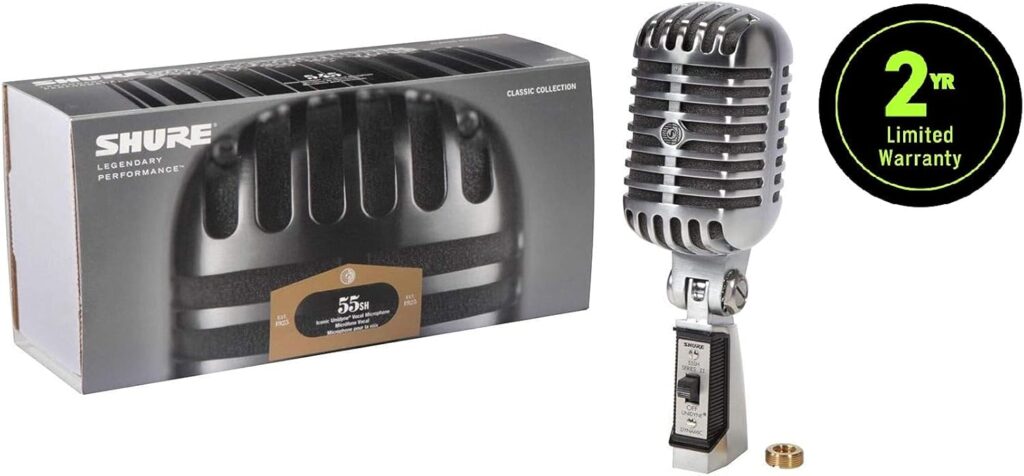
Priced around $199, the 55SH Series II sits in a mid-tier range for dynamic microphones. It’s more expensive than the Shure SM58 ($99) or the budget-friendly Audio-Technica ATR2100x ($99), but it justifies the premium with its unique design and vocal-specific tuning. Compared to modern alternatives like the Electro-Voice RE20 ($449) or Sennheiser MD 421-II ($399), it’s a bargain for what it offers, though those mics provide broader versatility.
The real question is whether the vintage appeal and sound profile are worth it. If you’re a performer or creator who values aesthetics as much as performance, the 55SH Series II is a no-brainer. For purely utilitarian needs, there are cheaper or more neutral options.
Pros and Cons
Pros:
- Iconic, eye-catching design
- Warm, vocal-friendly sound with excellent presence
- Durable, road-ready construction
- Great off-axis noise rejection
- No phantom power required
Cons:
- Limited versatility beyond vocals
- Fixed stand mount reduces flexibility
- Requires a pop filter for close-up work
- Slightly pricey for a dynamic mic
Conclusion
The Shure 55SH Series II isn’t just a microphone—it’s a statement. It bridges the gap between vintage charm and modern reliability, delivering a sound that’s rich, clear, and tailored for voices. While it won’t replace a do-it-all workhorse like the SM58 or a high-end studio condenser, it carves out a unique niche for performers, broadcasters, and creators who want to stand out visually and sonically.
In 2025, with audio technology advancing rapidly, the 55SH Series II remains a timeless choice. It’s not the most cutting-edge or versatile mic on the market, but it doesn’t need to be. For those who appreciate its heritage and character, it’s a worthy investment that proves classics never truly go out of style.


